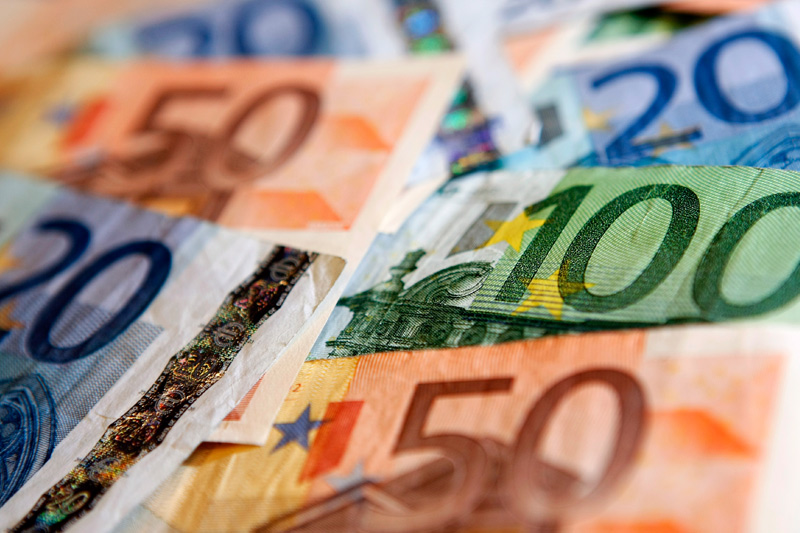Investing.com - The euro came off a three-and-a-half month high against the U.S. dollar and slid lower against the other major currencies on Monday, as investors booked profits following Friday’s steep gains ahead of a German court ruling on the euro zone's permanent bailout fund later in the week.
During European late morning trade, the euro was lower against the U.S. dollar, with EUR/USD down 0.29% to 1.2778.
Markets were jittery ahead of a German court ruling on the constitutionality of the European Stability Mechanism on Wednesday.
Demand for the single currency continued to remain supported after the European Central Bank unveiled details of its bond purchasing program, which is aimed at lowering the borrowing costs of peripheral euro zone members.
Earlier Monday, a report showed that investor confidence in the euro zone improved this month for the first time since March, largely due to optimism surrounding the ECB’s bond purchasing plan.
Meanwhile, the greenback remained under pressure after Friday’s disappointing jobs data underlined expectations that that the Federal Reserve will implement further stimulus measures to strengthen the economic recovery.
The single currency was down against the pound, with EUR/GBP losing 0.26% to trade at 0.7984.
The euro was lower against the yen, with EUR/JPY sliding 0.20% to trade at 100.07 and dipped against the Swiss franc, with EUR/CHF inching down 0.02% to 1.2099.
Earlier Monday, revised data showed that Japan’s economy expanded by 0.2% in the second quarter, down from a preliminary estimate of 0.3% growth.
The shared currency was mixed against the Australian, New Zealand and Canadian dollars, with EUR/AUD inching up 0.09% to 1.2349, EUR/NZD dipping 0.05% to 1.5767 and EUR/CAD shedding 0.45% to hit 1.2484.
In Australia, official data showed that home loan approvals fell by 1.0% in July, compared to expectations for a 0.1% increase, after a 1.0% decline in June.
Elsewhere, official data showed that China posted a wider-than-expected trade surplus in August as imports unexpectedly declined. China is Australia’s largest export destination.
Trade looked likely to remain subdued on Monday, as investors looked ahead to Wednesday’s German court ruling on the euro zone’s bailout fund, as well as the outcome of the Fed’s policy meeting on Thursday.
During European late morning trade, the euro was lower against the U.S. dollar, with EUR/USD down 0.29% to 1.2778.
Markets were jittery ahead of a German court ruling on the constitutionality of the European Stability Mechanism on Wednesday.
Demand for the single currency continued to remain supported after the European Central Bank unveiled details of its bond purchasing program, which is aimed at lowering the borrowing costs of peripheral euro zone members.
Earlier Monday, a report showed that investor confidence in the euro zone improved this month for the first time since March, largely due to optimism surrounding the ECB’s bond purchasing plan.
Meanwhile, the greenback remained under pressure after Friday’s disappointing jobs data underlined expectations that that the Federal Reserve will implement further stimulus measures to strengthen the economic recovery.
The single currency was down against the pound, with EUR/GBP losing 0.26% to trade at 0.7984.
The euro was lower against the yen, with EUR/JPY sliding 0.20% to trade at 100.07 and dipped against the Swiss franc, with EUR/CHF inching down 0.02% to 1.2099.
Earlier Monday, revised data showed that Japan’s economy expanded by 0.2% in the second quarter, down from a preliminary estimate of 0.3% growth.
The shared currency was mixed against the Australian, New Zealand and Canadian dollars, with EUR/AUD inching up 0.09% to 1.2349, EUR/NZD dipping 0.05% to 1.5767 and EUR/CAD shedding 0.45% to hit 1.2484.
In Australia, official data showed that home loan approvals fell by 1.0% in July, compared to expectations for a 0.1% increase, after a 1.0% decline in June.
Elsewhere, official data showed that China posted a wider-than-expected trade surplus in August as imports unexpectedly declined. China is Australia’s largest export destination.
Trade looked likely to remain subdued on Monday, as investors looked ahead to Wednesday’s German court ruling on the euro zone’s bailout fund, as well as the outcome of the Fed’s policy meeting on Thursday.
